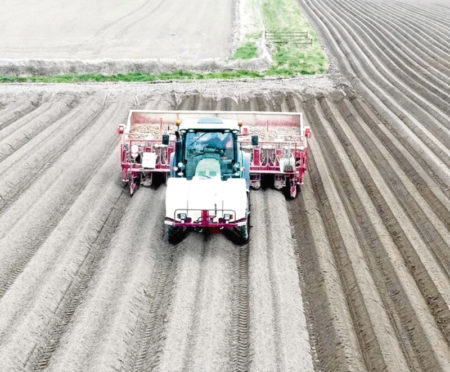Scottish potato growers could increase yields by reducing tillage operations in the planting process and by cutting the amount of nitrogen applied to the crop.
That was the message at a meeting of Scotland’s potato monitor farm at Coupar Angus yesterday.
The Strategic Potato Farm Programme, or SPot as it is known, is hosted at Bruce Farms, Meigle, Perthshire.
Findings from the second year of trials at the farm were revealed yesterday. Trials included further work on cultivation depths and new work looking at top dress applications of nitrogen.
Farm manager Kerr Howatson said four separate plots of Maris Piper were planted using different cultivation techniques.
These were: the farm standard of bedform, bedtill and destone at 12 inches; bedforming and destoning and 12 inches and bedtilling at six inches; bedforming at 12 inches and destoning at 10 inches, without bedtilling; and triple bedtilling at 12 inches followed by destoning at the same depth.
The planting costs, per hectare, associated with each cultivation technique were £82, £77.32, £45.53 and £59.21 respectively.
Mr Howatson said although the triple bedtiller technique was not the cheapest, it yielded the best results with a packout figure of 75.01% and a total yield of 43.38 tonnes per hectare (t/ha).
This compares to 52.89% and 28.33t/ha for the farm standard, 61.35% and 34.53t/ha for the reduced bedtillage plot, and 57.75% and 33.03t/ha for the no bedtilling plot.
Meanwhile, work looking at different application techniques and rates for a top dressing of nitrogen revealed the best packout figures and yields for the plot with no top dressing.
Four plots of Maris Piper were all were given the same amount of nitrogen in the planting process – 147kg per hectare – and 29kg was then applied as a top dressing in standard form, liquid form and by ridge injection. The plot that received no top dressing achieved a packout of 67.62% and yielded 40.88t/ha.
This compares to 64.88% and 36.05t/ha for the standard form, 64.58% and 37.47t/ha for the liquid form, and 62.89% and 37.76t/ha for the ridge injected plot.
Claire Hodge, knowledge exchange manager for AHDB, which runs the SPot project, said potato growers often applied the top dressing as insurance, but it could in fact be compromising the potential of the crop.
